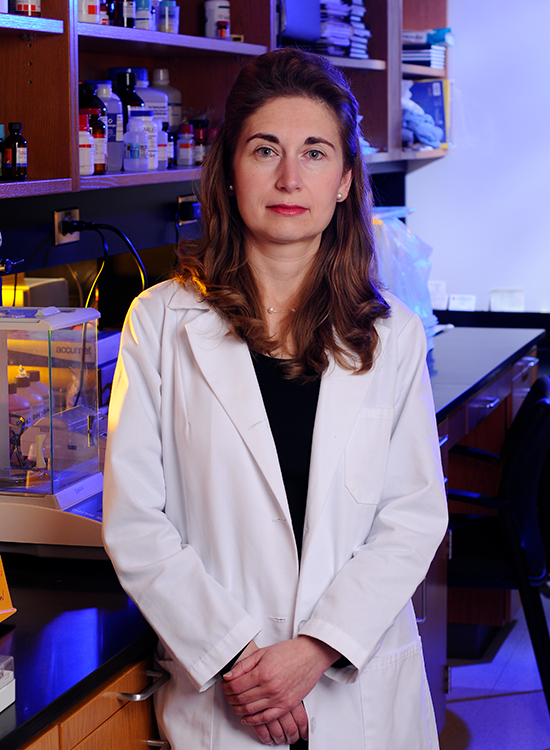 Anath Shalev, M.D.In groundbreaking diabetes research over the past two decades, Anath Shalev, M.D., has shown that the protein TXNIP regulates survival and function of beta cells, the pancreatic cells that produce the hormone insulin to lower levels of glucose in the blood. Downregulation or inhibition of TXNIP in beta cells protects against diabetes in mouse models, and a repurposed clinical drug that inhibits TXNIP shows promising results in people with recent-onset Type 1 diabetes.
Anath Shalev, M.D.In groundbreaking diabetes research over the past two decades, Anath Shalev, M.D., has shown that the protein TXNIP regulates survival and function of beta cells, the pancreatic cells that produce the hormone insulin to lower levels of glucose in the blood. Downregulation or inhibition of TXNIP in beta cells protects against diabetes in mouse models, and a repurposed clinical drug that inhibits TXNIP shows promising results in people with recent-onset Type 1 diabetes.
Beta cells play a key role in the pathogenesis of both Type 1 and Type 2 diabetes. However, pancreatic islets also have alpha cells that produce the hormone glucagon, which acts to raise glucose blood levels. Together, insulin and glucagon keep blood glucose levels stable.
To further understand the role of TXNIP in pancreatic islet biology and glucose control, Shalev and colleagues at the University of Alabama at Birmingham now report the effect of knocking out TXNIP in alpha cells.
While not as dramatic as beta-cell TXNIP knockouts, the alpha-cell knockout improved diabetes-associated hyperglycemia and hyperglucagonemia in a mouse model of streptozotocin-induced diabetes. Hyperglycemia and hyperglucagonemia — excess levels of glucose and glucagon in the blood — are hallmarks of diabetes.
The alpha-cell knockouts, known as aTKO mice, had normal glucose homeostasis and no gross abnormalities when fed on regular chow food. However, when the aTKO mice were fed a high-fat diet for 30 weeks to create glucose intolerance, they had a reduced high-fat diet-induced glucose intolerance compared to control mice on the high-fat diet. Glucose intolerance is an impaired ability to respond to a surge of dietary glucose.
In the knockout mice, there was no change in the architecture of the aTKO islets and the alpha cell numbers were unchanged. Furthermore, the expression levels of the glucagon gene and key islet transcription factors showed no change. However, glucagon secretion was decreased more than twofold in the aTKO islets compared to controls.
Out of five proteins recently reported to be involved in alpha cell glucagon expression, only one, Grp78, had significantly changed expression in the aTKO islets. This protein was recently confirmed to interact with glucagon in secretory granules, and it acts as a molecular chaperone in the cell’s endoplasmic reticulum, the transportation system of the cell where proteins are produced.
Thus, it appears that downregulation of alpha cell TXNIP can inhibit alpha cell glucagon secretion, which in turn may help explain the improvement in hyperglucagonemia and hyperglycemia observed in diabetic aTKO mice.
“Interestingly, we recently found that pharmacological inhibition of TXNIP with a small molecule inhibitor also resulted in decreased alpha cell glucagon secretion in vitro in alphaTC1-6 cells and in vivo in different diabetes mouse models,” said Shalev, director of the UAB Comprehensive Diabetes Center and professor in the Department of Medicine Division of Endocrinology, Diabetes and Metabolism. “These findings strongly support our current results using genetic TXNIP deletion and together suggest that alterations in TXNIP regulate alpha cell glucagon secretion.”
Co-authors with Shalev on the paper, “Alpha cell TXNIP deletion improves diabetes-associated hyperglycemia and hyperglucagonemia,” published in the journal Endocrinology, are Brian Lu, Junqin Chen, Guanlan Xu, Truman B. Grayson, Gu Jing and SeongHo Jo, all members of the UAB Comprehensive Diabetes Center and the UAB Department of Medicine, Division of Endocrinology, Diabetes and Metabolism.
Support came from National Institutes of Health grants DK078752 and Human Islet Research Network DK120379.
At UAB, Shalev holds the Nancy R. and Eugene C. Gwaltney Family Endowed Chair in Juvenile Diabetes Research. Medicine is a department in the Marnix E. Heersink School of Medicine.